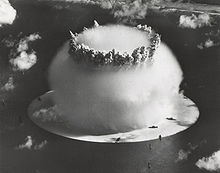| This article needs additional citations for verification. Please help improve this article by adding citations to reliable sources. Unsourced material may be challenged and removed. Find sources: "Condensation cloud" – news · newspapers · books · scholar · JSTOR (August 2020) (Learn how and when to remove this message) |


A transient condensation cloud, also called a Wilson cloud, is observable surrounding large explosions in humid air.
When a nuclear weapon or high explosive is detonated in sufficiently humid air, the "negative phase" of the shock wave causes a rarefaction of the air surrounding the explosion but not of the air contained within it. The rarefied air is temporarily cooled, which causes condensation of some of the water vapor within the rarefied air. When the pressure and temperature return to normal, the Wilson cloud dissipates.
Mechanism
Since heat does not leave the affected air mass, the change of pressure following a detonation is adiabatic, with an associated change of temperature. In humid air, the drop in temperature in the most rarefied portion of the shock wave can bring the air temperature below its dew point, at which moisture condenses to form a visible cloud of microscopic water droplets. Since the pressure effect of the wave is reduced by its expansion (the same pressure effect is spread over a larger radius), the vapor effect also has a limited radius. Such vapor can also be seen in low pressure regions during high–g subsonic maneuvers of aircraft in humid conditions.
Occurrence
Nuclear weapons testing
Scientists observing the Operation Crossroads nuclear tests in 1946 at Bikini Atoll named that transitory cloud a "Wilson cloud" because the same pressure effect is employed in a Wilson cloud chamber to let condensation mark the tracks of electrically-charged sub-atomic particles. Analysts of later nuclear bomb tests used the more general term condensation cloud.
The shape of the shock wave (influenced by different speed in different altitudes), and the temperature and humidity of different atmospheric layers determine the appearance of the Wilson clouds. During nuclear tests, condensation rings around or above the fireball are commonly observed. Rings around the fireball may become stable and form rings around the rising stem of the mushroom cloud. The lifetime of the Wilson cloud during nuclear air bursts can be shortened by the thermal radiation from the fireball, which heats the cloud above to the dew point and evaporates the droplets.
Non-nuclear explosions

Any sufficiently large explosion, such as one caused by a large quantity of conventional explosives or a volcanic eruption, can create a condensation cloud, as seen in Operation Sailor Hat or in the 2020 Beirut explosion, where a very large Wilson cloud expanded outwards from the blast.
Aircraft and rockets
The same kind of condensation cloud is sometimes seen above the wings of aircraft in a moist atmosphere. The top of a wing has a reduction of air pressure as part of the process of generating lift. This reduction in air pressure causes a cooling and the condensation of water vapor. Hence, small, transient clouds appear. The vapor cone of a transonic aircraft or rocket on ascent is another example of a condensation cloud.
See also
References
- Glasstone, Samuel and Philip J. Dolan. The Effects of Nuclear Weapons, U.S. Dept. Of Defense/ Dept. Of Energy; 3rd Edition (1977), p. 631
- ^ Howes, Laura (5 August 2020). "The chemistry behind the Beirut explosion". Chemical and Engineering News. Retrieved 7 August 2020.
- Yokoo, Akihiko; Ishihara, Kazuhiro (23 March 2007). "Analysis of pressure waves observed in Sakurajima eruption movies". Earth, Planets and Space. 59 (3): 177–181. Bibcode:2007EP&S...59..177Y. doi:10.1186/BF03352691.
- "KN-11352 Operation "Sailor Hat", 1965". Naval History and Heritage Command. Retrieved 7 August 2020.